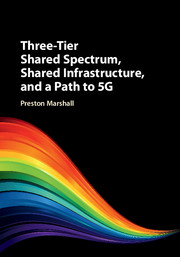Book contents
- Frontmatter
- Contents
- Acknowledgments
- Preface
- Part I Spectrum Sharing Background
- Part II Three-Tier Dynamic Spectrum Models
- Part III Components of a Three-Tier Architecture
- Part IV Protection Processes for Incumbents and Peers
- Part V Example Use of Three-Tier Spectrum: Use of the 3.5 GHz CBRS Band in the USA
- 13 Device and Network Interaction with the Spectrum Access System
- 14 CBRS SAS Requirements
- Part VI Future Bands, Network Services, Business Models, and Technology
- Part VII Appendices
- Index
- References
14 - CBRS SAS Requirements
from Part V - Example Use of Three-Tier Spectrum: Use of the 3.5 GHz CBRS Band in the USA
Published online by Cambridge University Press: 30 August 2017
- Frontmatter
- Contents
- Acknowledgments
- Preface
- Part I Spectrum Sharing Background
- Part II Three-Tier Dynamic Spectrum Models
- Part III Components of a Three-Tier Architecture
- Part IV Protection Processes for Incumbents and Peers
- Part V Example Use of Three-Tier Spectrum: Use of the 3.5 GHz CBRS Band in the USA
- 13 Device and Network Interaction with the Spectrum Access System
- 14 CBRS SAS Requirements
- Part VI Future Bands, Network Services, Business Models, and Technology
- Part VII Appendices
- Index
- References
Summary
Introduction to the SAS Design
This chapter will discuss the design of a specific implementation of a three-tier admission control system; in this example, the United States (US) Citizens Broadband Radio Service (CBRS) Spectrum Access System (SAS). The SAS discussed in this chapter is very much an image of the Citizens Broadband Radio Service Devices (CBSD) interface design described in the previous chapter. That chapter outlines the operation of the SAS in responding to an access point or point-to-point end node under the CBRS regulations. Much of this chapter parallels the interface discussion in the previous chapter, except from the perspective of the SAS side of the transaction.
The US implementation of a three-tier admission control system is the first ever specified through regulation, or implemented. The emphasis is therefore heavily biased towards protection of the current incumbents in the band, and the assurance of no bad outcomes as initial experience is gained in the band. It can be anticipated to mature, and relax, some of the extremely low-risk control specifications that are currently in place. Nevertheless, it is the best current example of such a system, and worth examination in detail.
For this reason, the US design of the CBRS SAS should not be considered an example that is universal. It is the best point of departure to examine the design and functionality consequences of one set of regulations for three-tier spectrum. Where specific features might be unique to the US regulations, they are noted in the text.
Although it is not explicit in the regulations, the presumed model of the SAS implementation is an application on one of the large-scale public or private cloud computing infrastructures, such as operated by Amazon Web Services (AWS), Microsoft Azure, or Google Cloud Platform (GCP). Such services provide redundant processing and communications capacity, internet exchange services, and failover. Therefore, the computer science related aspects of the design, such as backup, reliability, database management, and the like will not be further discussed here, as they are specific to the cloud service that would be selected, have been addressed in much more complex and stressed applications, and are not unique to the SAS functionality.
Information
- Type
- Chapter
- Information
- Publisher: Cambridge University PressPrint publication year: 2017
